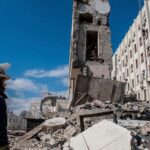
Russia’s grinding attack on Ukraine is threatening to drag on for weeks, worsening the death toll on both sides and exacerbating an already serious humanitarian crisis.
Russian President Vladimir Putin seriously miscalculated the ability of his forces to overcome the Ukrainians quickly, a mistake that has led to heavy losses for the Kremlin, according to officials and experts.
Russian forces are now likely to remain largely stalled until the later spring and summer, when the weather improves and vehicles can move off the roads. Meanwhile, the U.S. and its allies have fortified the Ukrainian forces with additional weaponry to halt the movement of the Kremlin assault, which has entered its fourth week.
“In a sense, we’ve helped the Ukrainians bottle up the Russian forces in these road networks,” said Michael O’Hanlon, a senior fellow at the Brookings Institution who specializes in U.S. defense strategy and national security policy.
While a diplomatic agreement could bring a quicker end to the war, it’s unclear whether Putin, who is facing a vastly weakened Russian economy, will be willing to accept a deal that involves him pulling back forces. Secretary of State Antony Blinken said Thursday that Russia’s actions are “in total contrast to a serious diplomatic effort to end a war.”
O’Hanlon said that a diplomatic resolution that involves Ukraine agreeing to not join NATO is a “distinct possibility, to the extent Putin wants to recognize the bad position he’s in.” But he also said the U.S. military should be preparing for the possibility the war stretches on for weeks and even months.
President Biden, who is slated to travel to Brussels next week for NATO and European Council summits on the crisis, and other officials have warned in recent days that a protracted conflict is possible.
“I want to be honest with you: This could be a long and difficult battle,” Biden said Wednesday as he announced $800 million in drones, anti-aircraft systems, small arms, body armor and other weaponry to support Ukraine.
Since the conflict began on Feb. 24, Russia has suffered a staggering number of losses.
Ukraine’s Ministry of Defense claims that the Kremlin has lost 14,200 troops, 450 tanks, 1,448 armored combat vehicles, 201 artillery systems, 93 warplanes, 112 helicopters and three ships. Washington puts the troop estimate at a much lower 7,000 – but that number is still more than the number of U.S. military personnel killed in the Iraq and Afghanistan wars combined.
The Russians have also found it difficult to replace their forces, which have been bogged down while facing heavy resistance from the Ukrainians.
“We don’t have insight into every unit in every location. But we certainly have picked up anecdotal indications that morale is not high in some units,” a senior U.S. defense official told reporters Thursday. “Some of that is, we believe, a function of poor leadership, lack of information that the troops are getting about their mission and objectives, and I think disillusionment from being resisted as fiercely as they have been.”
One senior NATO intelligence official said it becomes more evident by the day that Putin “gravely miscalculated” in his invasion.
“Russia continues to face difficulties replacing its combat losses, and increasingly seeks to leverage irregular forces, including Russian private military corporations and Syrian fighters,” the official told reporters in Brussels on Wednesday, as reported by CNN.
But those outside forces don’t appear to be materializing, with no indications that Russia is moving large numbers of troops from Syria or other central Asian countries such as Tajikistan to help its forces in Ukraine, U.S. Central Command head Gen. Frank McKenzie told reporters Friday.
“We see little evidence of recruiting in Syria to bring people back to Ukraine. Not saying it couldn’t happen and I’m not saying that one or two or three or four haven’t gone but we haven’t seen any large-scale effort to do that,” McKenzie said.
Ukrainian forces, meanwhile, have fared far better than what the United States initially expected.
Lt. Gen. Scott Berrier, director of the Defense Intelligence Agency, acknowledged in testimony last week that he underestimated the Ukrainian forces’ readiness and will to fight.
“That was a bad assessment on my part,” he told lawmakers on the Senate Intelligence Committee.
The Ukrainian troops have also been helped out with a steady stream of lethal aid from the U.S. and NATO countries, and some 20,000 people from more than 50 countries have applied to join the new International Legion of Territorial Defense of Ukraine, according to Ukraine’s foreign ministry. The volunteer military unit, quickly set up to help beat back the Russian invasion, is Ukraine’s first foreign fighter regiment.
However, Russia is not without its gains. Its forces have made steady territorial movements around the city of Mariupol, the site of a theater bombing where civilians had taken cover this week.
At the same time, the Ukrainian forces executed counterattacks on Russian forces in Kyiv, inflicting “heavy damage” on the Russians, according to the group.
Russian state television also confirmed that the commander of the Kostroma airborne forces was killed in a battle with Ukrainian forces.
“I think anything could happen in the sense that the war has not gone according to plan,” said Charles Kupchan, a senior fellow at the Council on Foreign Relations who served as senior director for European affairs on the National Security Council in the Obama administration. “As a consequence, I think it’s difficult at this point to discern Russia’s war aims. I think it’s safe to say that Russia miscalculated on multiple fronts.”
U.S. intelligence has assessed the Russians still have approximately 90 percent of their combat power sent into Ukraine available to them. With that in mind, it would be difficult to imagine a clear-cut Russian defeat.
“I can’t see Russia just packing up and going home,” Kupchan said. “What I could see is a deal that would enable Putin to at least claim victory.”
Retired Lt. Gen. Ben Hodges made the case on MSNBC this week that the Russians would only be able to last another 10 days – which would be mid next week – provided the U.S. and its allies continue to accelerate assistance to the Ukrainians.
“We give the Ukrainians enough where they can outlast Russia until Russia culminates,” Hodges said on the network.
Meanwhile, Putin finds his country in an increasingly challenging position, which the U.S. argues has significantly weakened his standing.
The Russian economy has been hit hard by damaging sanctions imposed by the U.S. and Europe. Russian elites aligned with Putin have had their property blocked and assets seized. More than 400 companies have announced plans to stop operations in Russia, according to a list compiled by the Yale School of Management.
And despite a harsh crackdown on protests and free speech, Russian citizens have taken to the streets to protest the war. Earlier this week, a Russian state TV employee interrupted a news program carrying a sign that read in part “no war.”
“Putin is not in a good position,” Kupchan said. “And it’s conceivable to me that this is the beginning of the end of his long reign. And that’s because the war is not going well, there’s considerable opposition among the Russian public and Russian elites, the sanctions will cause greater dislocation over time, and so he’s not sitting pretty.”
But O’Hanlon said that Putin’s ability to control the narrative in Russia would allow him to spin the war in his favor to help himself retain power.
“He’s got his own twisted view of the world and he’s certainly capable of presenting that narrative to his own people,” O’Hanlon said. “He’s turned Russia into a disinformation haven and a quasi-dictatorship.”




